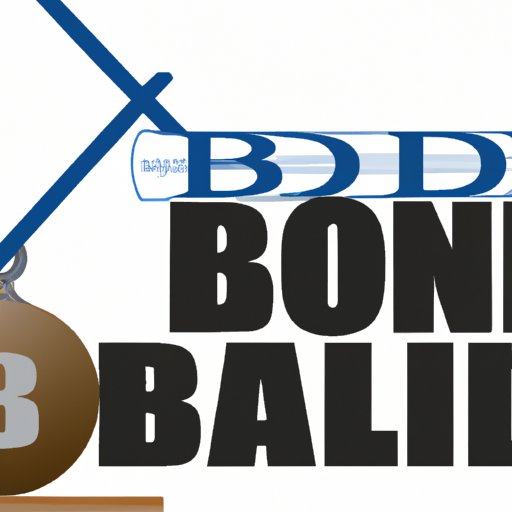
I. Introduction
The United States justice system allows people accused of crimes to be released from jail before their trial but on the condition that they pay a certain amount of money called bail. If the accused person attends all required court appearances, the money is returned at the end of their trial. However, not everyone can afford to pay their bail, which is where bail bond companies come in. They pay the bail amount themselves in exchange for a fee and a percentage of the bail amount as collateral. In this article, we will explore how the bail bond industry is a profitable business and how industry players make money.
II. Overview of the Bail Bond System
A bail bond is essentially a loan from a bail bond company to the accused person, with the collateral being the bail amount. Bail bond companies charge a non-refundable fee – usually 10 percent of the bail amount – for their services.
When a bail bond company issues a bail bond, they take on the risk that the accused person may not show up for court, which would result in a loss of the bail bond company’s money. To mitigate this risk, bail bond companies usually require collateral in the form of property or other assets worth at least the amount of the bail, which can be sold to offset any potential losses. The involvement of a bail bond company not only allows the accused person to be released from jail before their trial but also generates revenue for the bail bond industry.
In the bail bond process, bail bondsmen or agencies act as intermediaries between the accused person and the court system. They help people navigate the judicial system and secure their release from jail. After the initial payment of the fee, the bail bond company pays the bail amount to secure the release of the accused person. The accused person is then required to comply with the requirements of the court system, including attending all required court dates. If they do not, the bail bond company may hire a bounty hunter to bring them back to the jurisdiction for trial.
III. Financial Risks and Rewards of Being a Bail Bondsman or Agency
Like any business model, the bail bond industry has its own financial risks and rewards. Because of the high risk involved in this line of work, bail bond companies charge a non-refundable premium on their services.
Bail bondsmen or agencies have to weigh the financial risks involved in issuing bail bonds. They risk losing their investment if the accused person fails to attend court hearings, leading to a loss in collateral and fees paid. Therefore, they require collateral to compensate for the risk. However, if the accused complies with the court system’s requirements and pays their fees, the bail bond company stands to make a profit from the non-refundable fee at the very least.
IV. Fees and Charges Associated with Bail Bonds
Bail bond companies charge a non-refundable premium for their service, usually 10 percent of the total bail amount. This fee is based on the assumption that the accused person will attend all court appearances. If the accused person misses a court date, the bail bond company may hire a bounty hunter to bring them back, requiring the accused person to pay all costs associated with their capture.
Additionally, if the accused person uses collateral to secure the bond and it is forfeited due to a failure to appear in court, the bail bond company may sell the assets to pay their losses. There may also be other associated fees, such as jail release fees, payment plan fees, credit card fees, and interest rates, which can add up to considerable revenue for the bail bond company.
V. Market Competition and Advantages of Bail Bond Companies
Bail bondsmen or agencies operate in a competitive market, with many players vying for clients in the same area. Bail bond companies employ a variety of strategies to gain an advantage over their competitors, such as strong brand recognition, effective marketing campaigns, and excellent customer service.
In some jurisdictions, bail bond companies’ power and influence extend to sponsoring politicians who are in charge of the criminal justice system, influencing policies, and building relationships with law enforcement officials and attorneys. These strategies have allowed bail bond companies to build a reputation for reliability and trustworthiness, leading to more business and greater profits.
VI. Technology in the Bail Bond Industry
The introduction of new technologies has revolutionized the bail bond industry. Today, most bail bond companies have an online presence. They use websites to advertise their services, allow potential clients to apply for bail bonds online, and offer payment options. Many bail bond companies now use software to streamline their processes, allowing for faster processing times and increased efficiency.
Software applications have also made it easier for bail bondsmen to integrate their services with other bail bondsmen across the United States, allowing them to expand their operations and increase their profits. Recent technological advancements have also lowered costs for bail bond companies, allowing them to reduce their overheads and increase their profits.
VII. Networking and Building Relationships
Building relationships with law enforcement officials, attorneys, and other stakeholders involved in the judicial system is essential for bail bondsmen and agencies to thrive in the industry. Cultivating a network of trusted contacts can yield referrals and leads for new business opportunities.
Networking is not limited to building relationships with stakeholders in the judicial system. Bail bond companies should also consider networking with other businesses in the community. For instance, they can form strategic partnerships with rehabilitation centers and counseling agencies to provide support for clients who may be dealing with addiction or mental health issues.

VIII. Successful Bail Bondsmen and Women
There are many successful bail bondsmen and women in the industry, and they all have different strategies for achieving financial success. Some key strategies include building a strong brand image, fostering relationships with stakeholders in the judicial system, continuously improving their processes and investing in technology to streamline their operations, and providing excellent customer service.
One example of a successful bail bondsman is Ira Judelson, also known as the “bail king.” Judelson has handled high-profile cases and has grown his business by providing excellent service and building a solid reputation. Another example is Beth Chapman, who operates a bail bond company with her husband, Duane “Dog” Chapman. Beth has credited her success to her positive attitude, communication skills, and excellent marketing strategies.
IX. Conclusion
The bail bond industry is a lucrative business that requires significant financial risk-taking. Bail bond companies generate revenue by charging non-refundable fees and securing collateral for their services. There are also associated fees and charges that add up to profits for the companies. The industry is competitive, and successful bail bondsmen and agencies invest in technology, build relationships with stakeholders, and provide excellent customer service to thrive in the industry.
Readers should understand their options when dealing with bail bonds and carefully consider the risks and rewards before making any decisions. It’s also essential to find a trustworthy bail bond company that provides excellent service and has a good reputation in the community.





